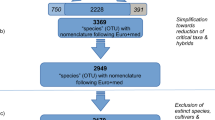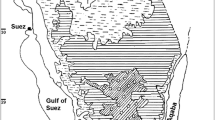Abstract
Assessing the representativeness of protected areas is necessary to optimize their national and regional networks, as well as to improve the protection of rare and endemic species. In the Republic of Bashkortostan, an analysis of the distribution of rare vascular plant species in need of protection has been carried out on the basis of synthesizing all sources of high-precision georeferenced data, i.e., databases of herbarium specimens and geobotanical relevés. The result of these works was the creation of a graphic database: the Rare and Endangered Species of Vascular Plants of the Republic of Bashkortostan GIS map. This GIS map includes three main vector layers: a point layer containing information about 4932 rare species localities, a Protected Areas Boundaries layer, and a grid layer with cells 6' in latitude by 10' in longitude (10.8 × 10.2 km). Based on these layers and standard procedures of the QGIS 3.4 program, an algorithm has been developed to analyze the patterns of distribution of rare species throughout the region, as well as to identify areas with a high diversity of these species and their covering by the existing network of protected areas. Using the example of two grid map cells with a high diversity of rare species, approaches to identifying and delineating further sites of protected areas have been considered using space images and a digital elevation model. To estimate the protection level of the unique combinations of rare species, the distribution of all sets of these species within the existing protected areas is assessed. This makes it possible to justify the creation of two new protected areas. This approach does not exclude, but significantly reduces the volume of field investigations and can significantly reduce the time and financial costs of creating new protected areas to optimize the protection of rare and endangered plant species.







Similar content being viewed by others
REFERENCES
Abaturov, B.D., Grazing type of functioning of steppe and desert ecosystems, Usp. Sovrem. Biol., 2006, vol. 126, no. 5, pp. 435–447.
Beckage, B. and Stout, I.J., Effects of repeated burning on species richness in a Florida pine savanna: a test of the intermediate disturbance hypothesis, J. Veg. Sci., 2000, vol. 11, no. 1, pp. 113–122. https://doi.org/10.2307/3236782
Biktashev, T.U., Baisheva, E.Z., and Fedorov, N.I., Basis for grid mapping of flora, vegetation and biological resources of the Republic of Bashkortostan, Estestv. Tekh. Nauki, 2019, no. 10, pp. 139–143. https://doi.org/10.25633/ETN.2019.10.22
Chepinoga, V.V. and Petukhin, V.A., “Flora of Central Siberia” (1979): the first experience of floristic grid mapping in Russia, Materialy VI Mezhdunarodnoi nauchnoi konferentsii posvyashchennoi 100-letiyu so dnya rozhdeniya Antoniny Vasil’evny Polozhii “Problemy izucheniya rastitel’nogo pokrova Sibiri,” g. Tomsk, 24–26 oktyabrya 2017 g. (Proc. VI Int. Sci. Conf. Dedicated to the 100th Anniversary of A.V. Plozhii “The Study of Vegetation Cover of Siberia,” Tomsk, October 24–26, 2017), Tomsk, 2017, pp. 115–117.
Chibilev, A.A., Stepi Severnoi Evrazii (Steppes of Northern Eurasia), Yekaterinburg: Ural. Otd., Ross. Akad. Nauk, 1998.
Gillet, F., Murisier, B., Buttler, A., Gallandat, J.-D., and Goba, J.-M., Influence of tree cover on the diversity of herbaceous communities in subalpine wooded pastures, Appl. Veg. Sci., 1999, vol. 2, no. 1, pp. 47–54. https://doi.org/10.2307/1478880
Gorchakovskii, P.L., Rasteniya evropeiskikh shirokolistvennykh lesov na vostochnom predele ikh areala (The Plants of European Broad-Leaved Forests at the Eastern Margin of Their Range), Sverdlovsk: Ural’skii Rabochii, 1968.
Gosudarstvennyi doklad “O sostoyanii i ob okhrane okruzhayushchei sredy Rossiiskoi Federatsii v 2018 godu” (The Governmental Report “On the State and Protection of Environment in Russian Federation in 2018”), Moscow: Kadastr, 2019.
Ko, C.Y., Murphy, S., Root, T., and Lee, P.F., An assessment of the efficiency of protection status through determinations of biodiversity hotspots based on endemic bird species, Taiwan, J. Nat. Conserv., 2014, vol. 22, no. 6, pp. 570–576. https://doi.org/10.1016/j.jnc.2014.08.012
Krasnaya kniga Respubliki Bashkortostan. Tom 1. Rasteniya i griby (The Red Data Book of Bashkortostan Republic, Vol. 1: The Plants and Fungi), Mirkin, B.M., Ed., Ufa: MediaPrint, 2011, 2nd ed.
Krasnaya kniga Rossiiskoi Federatsii (rasteniya i griby) (The Red Data Book of Russian Federation: Plants and Fungi), Moscow: KMK, 2008.
Krever, V.G., Stishov, M.S., and Onufrenya, I.A., Osobo okhranyaemye prirodnye territorii Rossii: sovremennoe sostoyanie i perspektivy razvitiya (Strictly Protected Natural Territories of Russia: Modern Conditions and Prospective Development), Moscow: Orbis Piktus, 2009.
Márialigeti, S., Tinya, F., Bidló, A., and Ódor, P., Environmental drivers of the composition and diversity of the herb layer in mixed temperate forests in Hungary, Plant. Ecol., 2016, vol. 217, no. 5, pp. 549–563. https://doi.org/10.1007/s11258-016-0599-4
Mirkin, B.M., Martynenko, V.B., Shirokikh, P.S., and Naumova, L.G., The analysis of the factors determining species richness of Southern Ural forest communities, Zh. Obshch. Biol., 2010, vol. 71, no. 2, pp. 131–143.
Mordkovich, V.G., Gilyarov, A.M., Tishkov, A.A., and Balandin, S.A., Sud’ba stepei (The Destiny of Steppes), Novosibirsk: Mangazeya, 1997.
Neufeld, H.S. and Young, D.R., Ecophysiology of the herbaceous layer in temperate deciduous forests, in The Herbaceous Layer in Forests of Eastern North America, Gilliam, F.S., Ed., Oxford: Oxford Univ. Press, 2014, pp. 35–95. https://doi.org/10.1093/acprof:osobl/9780199837656.001.0001
Plue, J., van Gils, B., De Schrijver, A., Peppler-Lisbach, C., Verheyen, K., and Hermy, M., Forest herb layer response to long-term light deficit along a forest developmental series, Acta Oecol., 2013, vol. 53, pp. 63–72. https://doi.org/10.1016/j.actao.2013.09.005
Sannikov, P.Yu., The network of specially protected natural areas of Perm krai: current state and prospective development, Cand. Sci. (Geogr.) Dissertation, Perm: Perm State Natl. Res. Univ., 2014. Sentinel-2, Ñopernicus. https://www.copernicus.eu/en/access-data.
USGS. https://earthexplorer.usgs.gov/.
van Couwenberghe, R., Collet, C., Lacombe, E., and Gégout, J.-C., Abundance response of western European forest species along canopy openness and soil pH gradients, For. Ecol. Manage., 2011, vol. 262, no. 8, pp. 1483–1490. https://doi.org/10.1016/j.foreco.2011.06.049
Weiher, E. and Howe, A., Scale-dependence of environmental effects on species richness in oak savannas, J. Veg. Sci., 2003, vol. 14, no. 6, pp. 917–920. https://doi.org/10.1111/j.1654-1103.2003.tb02226.x
Funding
This work was carried out as part of Government Contract of the Ministry of Education and Science of Russia no. 075-00326-19-00 on topic no. AAAA-A18-118022190060-6 and with financial support from the Russian Foundation for Basic Research as part of scientific project no. 19-34-90028.
Author information
Authors and Affiliations
Corresponding author
Ethics declarations
Conflict of interests. The authors declare that they have no conflicts of interest.
Statement on the welfare of humans or animals. This article does not contain any studies involving animals performed by any of the authors.
Rights and permissions
About this article
Cite this article
Fedorov, N.I., Muldashev, A.A., Martynenko, V.B. et al. Identifying Highly Diverse Areas of Rare Plant Species as a Basis for Assessing Representativeness and Improving the Network of Protected Areas. Contemp. Probl. Ecol. 13, 418–428 (2020). https://doi.org/10.1134/S199542552004006X
Received:
Revised:
Accepted:
Published:
Issue Date:
DOI: https://doi.org/10.1134/S199542552004006X




